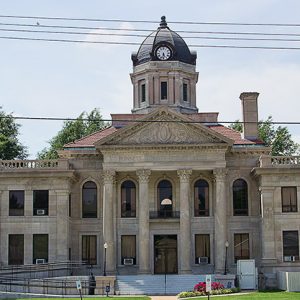calsfoundation@cals.org
Poinsett County Courthouse
The Poinsett County Courthouse—built in 1918—is located on Courthouse Square, a section of Harrisburg (Poinsett County) that features the city’s historic commercial district and a green space with a wooden gazebo. The Arkansas Historic Preservation Program recognizes the two-story building as architecturally and historically significant for its Classical Revival style and for its standing as the most impressive building in Poinsett County. It was added to the National Register of Historic Places on November 3, 1989.
The county’s first courthouse was located at Bolivar in 1839, the first county seat. A historical marker on the grounds tells how Benjamin Harris Sr., for whom Harrisburg was named, donated the land to the county to build a new courthouse when the seat of government was moved to Harrisburg in 1856. This was a two-story brick building that was fifty square feet. Not only were county affairs practiced in the utilitarian structure, but it was also used as a school, as a church, for real estate offices, and for newspaper publication. The building, which had cost $8,800, was gutted by a fire in 1873. A new courthouse, using the walls of the 1856 structure, was constructed in 1874.
Railroads came to Poinsett County in the 1880s, stimulating the economy and invigorating commerce. The only practical route to transport goods had previously been the St. Francis River, but the railroad meant that the agriculture and timber sectors that employed the bulk of the county could reach larger markets. The region found new wealth, and this resulted in revenue overflowing county coffers.
Another fire, on May 4, 1917, burned down the third Poinsett County Courthouse, providing an opportunity for the county to build a new courthouse to boost the county’s newfound stature. A month after the fire, County Judge S. T. Mayo ordered the construction of a new courthouse to replace the 1874 structure, amassing an astounding $200,000 in appropriations and levying a tax to fund the high budget. The county hired Mitchell Selligman, an architect from Pine Bluff (Jefferson County), to design a grand new courthouse, and J. E. Hollingsworth won the bid to be the project’s contractor.
Selligman designed an impressive and stately Classical Revival structure that is reminiscent of a Colonial government house. It was mostly constructed with gray Bedford stone and reinforced concrete. Its most striking features are the large Corinthian columns that are made of sandstone and stand on the eastern and western entrances. The columns support impressive pediments, which are identical on both entrances and are decorated with various molding styles. Other Classical features include a pyramid roof made with clay tiles, an octagonal clock tower that includes four faces, and the date of construction written above the entrances in Roman numerals—MCMXVIII (1918).
The elegant courtroom is the heart of the building. Eight gilded eagles with outstretched wings in the caps of Corinthian columns stand around the courtroom. Like the great columns outside, they are also made of sandstone. The walls are made of plaster with decorative plaster molding and Corinthian capitals. The grandness of the room is highlighted by an unusually large jury box that can fit eighteen jurors, six more than the traditional number who sit in trial proceedings.
A war memorial dedicated to veterans of Poinsett County is on the grounds. It is a simple gray stone slab and was erected on November 11, 1991.
For additional information:
Gill, John Purifoy, and Marjem Jackson Gill. On the Courthouse Square in Arkansas. N.p.: 1980.
Kemp, Ron. “Poinsett County Courthouse: Preserving Regional History for Future Generations.” Delta Crossroads (Summer 2018): 94–99.
“Poinsett County Courthouse.” National Register of Historic Places nomination form. On file at Arkansas Historic Preservation Program, Little Rock, Arkansas. Online at http://www.arkansaspreservation.com/National-Register-Listings/PDF/PO0002.nr.pdf (accessed October 22, 2020).
Jared Craig
Arkansas Historic Preservation Program
 Early Twentieth Century, 1901 through 1940
Early Twentieth Century, 1901 through 1940 Historic Preservation
Historic Preservation Poinsett County Courthouse
Poinsett County Courthouse  Poinsett County Courthouse
Poinsett County Courthouse 




Comments
No comments on this entry yet.